|
|
|
Sort Order |
|
|
|
Items / Page
|
|
|
|
|
|
|
| Srl | Item |
| 1 |
ID:
092415
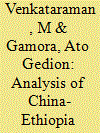

|
|
|
|
|
| Publication |
2009.
|
| Summary/Abstract |
This article analyses the bilateral relations between China and Ethiopia during the Cold War period and brings out the interplay of domestic, regional and extra-regional factors that went into the shaping of bilateral relations. China's growing involvement and various attempts at consolidation of political and economic relationship with African countries-a relatively recent phenomenon-is perceived as a result of the dynamic interplay of economic and political factors. As with other African countries, China's interaction with Ethiopia in the post-Cold War period is markedly different from pre-1990 years. This article investigates the political/economic factors underlying this shift. It describes and analyses the factors that led to China's political and economic ties with Ethiopia (and Africa) during the years of Mao and Deng Xiaoping. It concludes that motivated by the desire to realise its priorities and goals, China's venture into Africa and Ethiopia was shaped by the shift in relations between the United States (US) and China and the Cold War dynamics in the Horn that prevented any kind of consolidation of relations with Ethiopia on the one hand and regime change in Ethiopia on the other.
|
|
|
|
|
|
|
|
|
|
|
|
|
|
|
|
| 2 |
ID:
092418
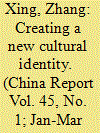

|
|
|
|
|
| Publication |
2009.
|
| Summary/Abstract |
Already in the nineteenth century, the Chinese immigrants had built several Chinese temples in Kolkata. These temples, including those dedicated to Tianhou and Guanyin, served not only as religious shrines but also meeting places for the community. This article outlines some of the unique, and hitherto unexamined, religious practices among the Kolkata Chinese. Specifically, it focuses on the venerations of the Atchew, perceived to be the first Chinese immigrant in India, the medium known as Lady Shou and the Indian Goddess Kali. While other religious beliefs among the Kolkata Chinese indicate the preservation of Chinese heritage and identity, these unique practices show the process of acculturation and the creation of a new mixed,Chinese-Indian identity.
|
|
|
|
|
|
|
|
|
|
|
|
|
|
|
|
| 3 |
ID:
092419
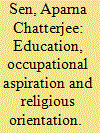

|
|
|
|
|
| Publication |
2009.
|
| Summary/Abstract |
There are only a few Chinese families settled in North Bengal, concentrated in the towns of Siliguri and Kalimpong. The Chinese have on an average been a literate community but few of them continued for post-secondary education. The reasons were that many of them were engaged in business at an early age which was much more lucrative and on the other hand some people were struggling to maintain their establishment. Economic challenges left little time and recourses to concentrate on education. However, since the community has prospered and with time, parents increasingly opt to send their children to school. These days, the occupational needs of the Chinese youth in North Bengal can be divided into two categories, either to migrate abroad or to be a successful businessman. It is perceptible that Chinese in India are conscious with regard to the education of their children. English-medium schools are the preferred institutions and for this the Chinese have adopted another strategy-that of conversion to Christianity. Since Christians have some concessions in the admission process, in Convent schools, many Chinese see conversion as a solely utilitarian issue
|
|
|
|
|
|
|
|
|
|
|
|
|
|
|
|
| 4 |
ID:
092416
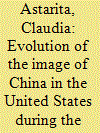

|
|
|
|
|
| Publication |
2009.
|
| Summary/Abstract |
This article describes the evolution of the image of China in the United States (US) during the Cold War. Aware that China-US bilateral relations have been influenced by periods of conflict and animosity, harmony and détente, the article argues that the image of China has always been embedded in a network of events-birth of the PRC (People's Republic of China [PRC], Korean War, Sino-Soviet alliance) that prevented American public opinion from developing an objective and unbiased picture of the PRC. Since 1950s, China has always been linked to the idea of the 'Yellow Peril'. Moreover, the lack of a direct contact between China and America further thwarted the opportunity of shaping a fair picture of the PRC. Although recognising that during the Cold War American political parties played a significant role in conveying a negative image of China, this article shows how media helped in strengthening Chinese stereotypes among the American public. Analysing all articles published by Time, National Geographic and Readers' Digest from 1949 to 1972, the article highlights both similarities and differences of the way in which these magazines introduced China to their readers.
|
|
|
|
|
|
|
|
|
|
|
|
|
|
|
|
| 5 |
ID:
092417
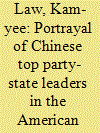

|
|
|
|
|
| Publication |
2009.
|
| Summary/Abstract |
The three decades of "world-shaking" reform and the opening up are believed to have brought enormous changes to China. Today, few can deny China's crucial position in the global economy. However, aside from the obvious economic changes, it is uncertain whether the previously mysterious, untouchable and reclusive China thoroughly reformed itself from the demonized character during the globalization trend and years after the Cold War. Today, when 'national image becomes an important part in soft power competition among countries...and a very significant strategic issue China faces in the development process', this article aims at examining the scope and specific 'frames' that American mainstream news media use to report on China's party-state leaders over the past 3 decades. Through the contents analysis of Time and Newsweek, the study finds that the image of China's party-state leaders has not been drastically different under the framing. Since the judging criteria for the American mainstream news media towards political leadership has not significantly changed, they would still show certain disapprovals to the political aspects of China not change at all even after thirty years reform.
|
|
|
|
|
|
|
|
|
|
|
|
|
|
|
|
| 6 |
ID:
092420
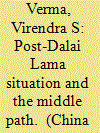

|
|
|
|
|
| Publication |
2009.
|
| Summary/Abstract |
I was invited to make a presentation on the Post-Dalai Lama Situation and the Middle Path subject at the Ethnic Minority Groups Development Research Institute of Development Research Centre of the State Council, Beijing, People's Republic of China (PRC).
|
|
|
|
|
|
|
|
|
|
|
|
|
|
|
|
| 7 |
ID:
092414
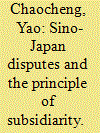

|
|
|
|
|
| Publication |
2009.
|
| Summary/Abstract |
Regional economic unification must overcome some economic obstacles, such as how to remove the trade and non-trade barriers, how to realise monetary stability in the region and how to develop a regional market, dominated by internal demand. However, in the long run, social obstacles will be more troublesome than the economic obstacles and could also be counterproductive. The integration process in Asia has been lagging behind the other continents of Europe and North America for many reasons. One of them is that the Asian unification process has mainly been a top-down approach by politicians and leaderships in this region, without wider and broader participation from the societies and civil groups. Nonetheless, there are strong trends favouring the ongoing regional cooperation in Asia. While envisioning bright prospects, the Asian economic integration process, however, is destined to encounter social obstacles. One of them is clearly the Sino-Japan dispute. The article argues, that the principle of subsidiarity (bottom-up approaches) (Horst Rolly 2003) being applied in European unification, may serve as the key solution-and strategic approach-to improve Sino-Japan relations. Asian nations, especially China and Japan, could draw on the lessons and experiences of European countries and adapt from their principle of subsidarity, which may serve to overcome the impending obstructions. Otherwise, the Sino-Japan dispute may become the largest barrier in building up the regional cooperation structure in Asia.
|
|
|
|
|
|
|
|
|
|
|
|
|
|
|
|
|
|
|
|
|